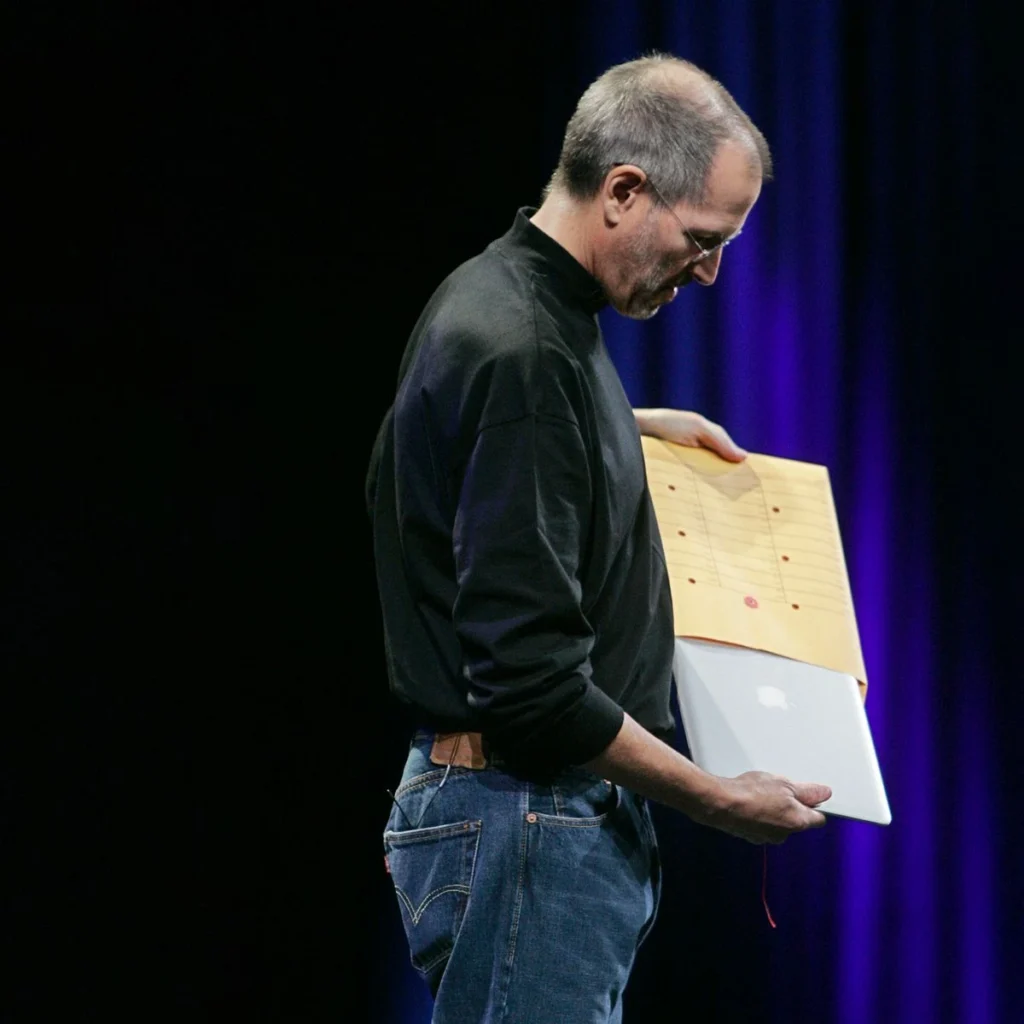If anyone knew how to turn something simple into magic, it was Steve Jobs.
He was a techie but a marketing master as well. He never sold a product; rather, he sold dreams and emotions, as well as the idea of “what could be.” Today we will be diving into how his marketing moves made Jobs a legend—and how to apply the same insights so you can revolutionize your very own business strategy.
1. Marketing is About Values
Steve Jobs once said, “Marketing is about values.” This simple yet profound statement was his entire philosophy. People won’t remember you unless you stand out from the crowd. That’s why Apple’s marketing never focused on speeds, feeds, or technical specs. Instead, it focused on one core value: People with passion can change the world.
2. Turn Features Into Stories: The MacBook Air in an Envelope
How do you describe “thin” when everyone claims their product is the thinnest? You don’t declare it—you demonstrate it. This is what Jobs did by presenting the MacBook Air, rather than talking about the number of millimeters and dimensions. He advertised the MacBook Air by taking it out of an envelope to put in vision, not words, how thin it is.

It’s been 11 years since the marketing genius did this. People still to this day talk about it and make short-form videos on Instagram and YouTube. All of it gets at least 100k likes because indeed it truly was an unregrettable way of marketing.
Instead of listing features, think of a creative, visual way to demonstrate the product’s unique quality. People will remember the “envelope moment” long after they’ve forgotten the product’s dimensions.
3. Price anchoring
Steve Jobs built the iPad in January, and as he walked onto the stage in The Cradle of Tutorium, the crowd erupted into a standing ovation before he even said a single word. Three years earlier, he had already changed the world with the iPhone, and now Apple was ready for the next big thing.
After building the iPad, the world was filled with just workspecting. Everyone had one question in mind—the price. Many expected the iPad to be priced at $999, but Jobs had something else in store. He stood proudly on stage and cleared the air. The cost wasn’t what people had feared. It was a moment of pure brilliance. Fortnite wild reactions filled the room as Jobs revealed the true price.
This move wasn’t random. It was rooted in Jobs’ mastery of price anchoring—a marketing strategy grounded in consumer psychology. Here’s how it worked:
First, Jobs dropped a reference point—a high price that everyone would latch onto. He told the world, “If you listen to the pundits, we’re going to price it under a thousand dollars,” which everyone understood as $999. This was the anchor, the “too expensive” price point. Then, he delivered the twist: “The iPad will not start at $999 but at… $499!”
The room exploded. Suddenly, $499 felt like a bargain. By framing the iPad’s price this way, Jobs made people feel like they were getting a deal. This strategy works because of how people perceive value—they rely on the first number they hear as a reference, and any price lower than that feels like a win.
To this day, Apple continues to use “price angry” in its marketing. It’s a strategy that plays with expectations, builds hype, and delivers satisfaction. And it all started with that unforgettable iPad reveal.
Use price anchoring in your own business. When pitching a new product or service, introduce a “higher” price point first, then offer your actual price. This technique frames the offer as a steal, boosting its perceived value.
4. Steal Smartly
Steve Jobs Copied Picasso to Make Apple $350 Billion—Here’s How
In 1945 Picasso created a masterpiece—the Bull. But really, take a good look at it. Over 11 iterations, Picasso takes the complex structure of a bull and keeps simplifying it, step by step, until it’s just lines—the very essence of a bull.
And of course, our pal Steve Jobs gets a hold of this concept. “Ah, here it is. I love it,” he says. “And today, you must all love it too.” This idea became the foundation of Apple’s approach to design.
This is why Apple launched Apple University, a place dedicated to studying Picasso’s bull and making sure that just the essence remains at the forefront of all Apple design. It’s the reason why Apple moved from a complex mouse to a simplified trackpad.
It’s not what you copied; it’s how you innovate that makes a product indispensable. Xerox had the idea, but Apple transformed it.
5. Think Different
Apple’s “Think Different” campaign goes down in history for this reason. It did not focus on new features and hardware. The campaign featured iconic visionaries like Albert Einstein, Martin Luther King Jr., and Mahatma Gandhi.
Why this? We all are naturally attracted to things that are potentially greater in value. If your brand represents a dream or an aspiration, the customer will feel part of something greater than themselves. That is why people do not buy Apple; they join it.
6. Less is More
Jobs was a minimalist in designing, in language, and in strategy. His competitors stuffed products with features; he took everything that was unnecessary out of it. Look at the original iPod. It wasn’t “500MB of storage and MP3 compatibility.” It was “1,000 songs in your pocket.”
That was:
- Simple.
- Memorable.
- Iconic.
Complexity confuses. Simplicity sells.
7. Don’t Just Advertise
When Jobs came back to Apple, he wanted not only to repair its marketing but also to repair its soul. He realized that brand loyalty built on flashy advertising; it depends on values and beliefs.
Steve Jobs was a master of human psychology. He understood the power of perception, emotion, and storytelling. Every product launch was a performance; every ad campaign a statement of belief. Now it is your time to apply these marketing insights in your business!
Steve Jobs mastered storytelling, suspense, and lifestyle branding. His presentations created excitement, while his “less is more” design philosophy made Apple products iconic.
Jobs believed marketing was about values, emphasizing storytelling and emotional connection. He stated that brands must make a lasting impression in a noisy world.
Apple’s success lies in its minimalistic design, emotional storytelling, and lifestyle branding, all of which stem from Steve Jobs’ marketing strategy.
Storytelling was central to Jobs’ marketing. He created emotional, memorable narratives for product launches, making people feel connected to Apple’s mission.



